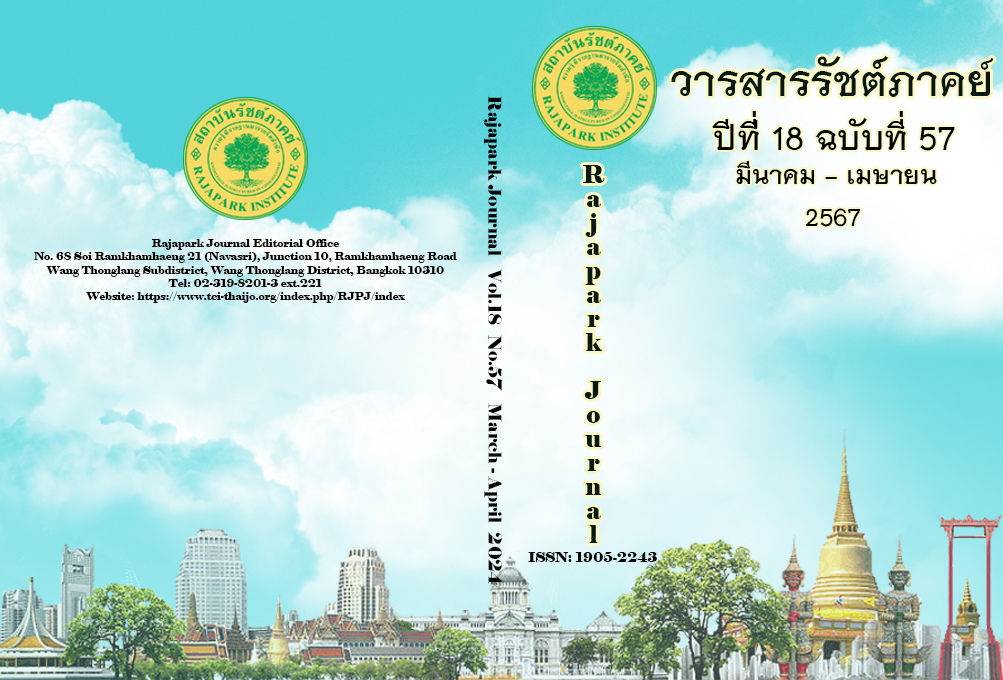A Formation of Community Strength from Floating Market Tourism Meaning Construction and Community Governance: A Case Study of Wat Khae Nok Pracharat Floating Market, Muang District, Nonthaburi Province
Main Article Content
Abstract
This research aimed to study 1) the meaning construction patterns of tourism influenced the formation of community strength. 2) community governance patterns in the form of floating markets; and 3) a formation of community strength processes from floating market management. By using a qualitative research approach and a structured interview to collect data. Key informants are the floating market board of directors, public officials, entrepreneurs, and people. The research results were found as follows: 1) The construction patterns of tourism are influenced by the formation of community strength, namely: naturalization, localization, standardization, and diversification. 2) Community governance patterns in the form of a floating market are found, namely: a strong leader, the local administrative organization giving support, the setup of community participation processing, the establishment of rules and regulations and collective agreement, the creation of community networking, the establishment of allies outside the community, and the creation of trust. 3) A formation of community strength processes from tourism management shows that Wat Khae Nok Pracharat floating market generates additional income for the villagers, establishing norms of interdependence, career and business integration, capital formation, welfare distribution, and the participation process of the villagers.
Article Details

This work is licensed under a Creative Commons Attribution-NonCommercial-NoDerivatives 4.0 International License.
Views and opinions appearing in the Journal it is the responsibility of the author of the article, and does not constitute the view and responsibility of the editorial team.
References
Adorno, T. W., & Rabinbach, A. G. (1975). Culture Industry Reconsidered. New German Critique, 1(6), 12-19. https://www.jstor.org/stable/i221164
Ajzen, I. (1991). The Theory of Planned Behavior. Organizational Behavior and Human Decision Process, 50(1), 179-211. https://doi.org/10.1016/0749-5978(91)90020-T
Ajzen, I., & Fishbein, M. (1980). Understanding Attitudes and Predicting Social Behavior. Prentice-Hall.
Barthes, R. (1988). Semiology and Urbanism. In R. Barthes. The Semiotic Challenge (pp. 191-201). Hill and Wang.
Benjamin, W. (1969). The Work of Art in the Age of Mechanical Reproduction. Schocken Books.
Bureekul, T. (2009). Public Participation Dynamics: From the Past to the Constitution of the Kingdom of Thailand 2007. AP Graphic Design and Printing.
Diets, T., & Stern, P. C. (2008). Public Participation in Environmental Assessment and Decision Making. The National Academies.
Dubrin, J. (1998). Leadership Research Finding: Practice and Skills. Mifflin Company.
Fennell, D. A. (2008). Ecotourism: An introduction. Routledge.
Havanon, N. (2007). Grounded Theory in the Community Strength. The Thailand Research Fund (TRF).
Khanthawichai, S., Thammacharo, S., Kamapanyo, S., & Chandsoda, S. (2022). A Strengthened Community: A New Alternative Towards Political Development. Journal of MCU Ubon Review, 7(3), 323-338. https://so06.tci-thaijo.org/index.php/mcjou/article/view/260783
Kiriwong, K., Prisi, W., & Chachawan, O. (2021). Consumer Behavior and Motivating Factor for Purchaing Souvenirs: A Case Study of Ban Pha Khong, Huai Som Sub-District, Phu Kradueng District, Loei Province. Udon Thani Rajabhat University Academic Journal, 9(2), 68-85. https://so06.tci-thaijo.org/index.php/UDRUAJ/article/view/251720
Koment, J., Panyadee, C., Ekiem, B., & Techatunminasakul, S. (2020). Influence of Community-Based Tourism Promotion Policy on Solidarity of Tourism Communities in Thailand: The Theoretical Perspective. International Thai Tourism Journal, 15(2), 88-105.
https://so02.tci-thaijo.org/index.php/jitt/article/view/190249
Kotler, P. (2003). Marketing Management. Prentice-Hall.
Mahatamnuchok, N. (2022). Development of a Tourism Activity Base on Nature Conservation and Environment with Rural Lifestyle of Tamrong Ban-Lat District Phetchaburi. Social Science Journal of Prachachuen Research Network, 4(3), 50-62. https://so03.tci-thaijo.org/index.php/prn/article/view/264919
Na Chiangmai, C. (2000). Human Resource Development Management in Effective Organization. Legislative Institutional Repository of Thailand, 39(10), 37-47. https://dl.parliament.go.th/backoffice/viewer2300/web/viewer.php
Nakabutr, A. (2007). Information and Development Sustainability. Local Development Institute.
Panpeng, V. (2022). Localization Processes and Social Capital Values for Tourism Management. Journal of MCU Ubon Review, 7(3), 457-470. https://so06.tci-thaijo.org/index.php/mcjou/article/view/260944
Peirce, C. S. (1955). Philosophical Writing of Peirce. Selected and Edited with an Introduction by Justus Buchler. Dover.
Petchprasert, N. (1999). Community Business, Possible Path. The Thailand Research Fund.
Phoochinda, W., & Patthanacharoen, N. (2021). Eco-friendly Tourism: A case study of Ban Sa Nam community, Ban Rai sub-district, Ban Rai district, Uthai Thani province. Research and Development Journal Suan Sunandha Rajabhat University, 13(2), 301-319. https://so05.tci-thaijo.org/index.php/irdssru/article/view/252386
Piriyarangsan, S. (1998). Self-Reliant Community Economy Towards the Future Position Philosophy in the Ministry of Interior, Self-Reliant Community Economy Towards the Concept and Strategy. Songsitsuwan.
Pongpit, S., Nanthasuwan, W., & Rakpinit, J. (2001). Community Enterprise: Master Plan, Concept, Guidelines, Examples, Draft Act. Bumipanyathai.
Putnam, R. (1993). The Prosperous Community: Social Capital and Public Life. The American Prospect, 4(13), 35–42.
Samukkethum, S. (2008). Development, Conflict Management, Participation, Societal Strength. News Maker.
Sativepullo, N., & Wattnapradith, K. (2022). Community Strengthening through Culture of Peace of Tai Doeng Ethnicity in Nakhon Ratchasima Province. Journal of MCU Peace Studies, 10(7), 3130-3142. https://so03.tci-thaijo.org/index.php/journal-peace/article/view/261580
Saussure, Ferdinand de. (1959). Course in General linguistics. Edited by Charles Bally and Albert Sechehaye in Collaboration with Albert Riedlinger. Translated, with an introduction and notes by Wade Baskin. McGraw-Hill.
Wasi, P. (1999). Sufficiency Economy and Civil Society: Guidelines for Transforming the Economy and Society. Moh-Chao-Ban. http://library1.nida.ac.th/catbook1/seco1/b101229.pdf
Wongleedee, K., & Yiamjanya, S. (2012). Market Factors and Safety Factors of Foreign Tourists at Jatujak Market[Research Report, Suan Sunandha Rajabhat University].
Woravat, T., Kanaphum, S., & Kosonkittiumporn, S. (2019). Factors Affected the Strength of Nawatwithi OTOP Tourism Community in Nakhon Ratchasima Province. NEU Academic and Research Journal, 9(2), 71-80. https://so04.tci-thaijo.org/index.php/neuarj/article /view/213336


